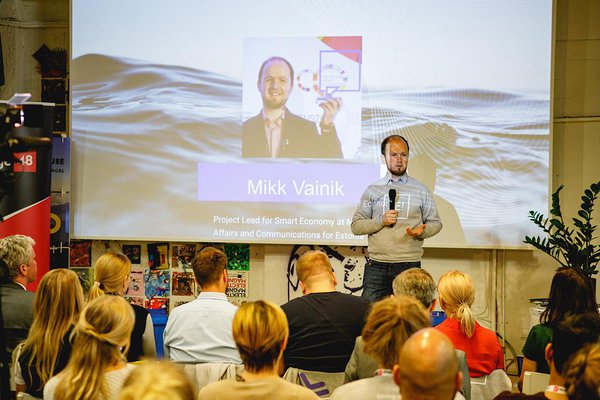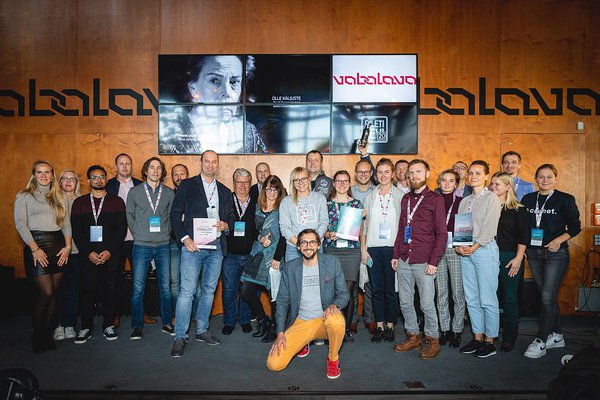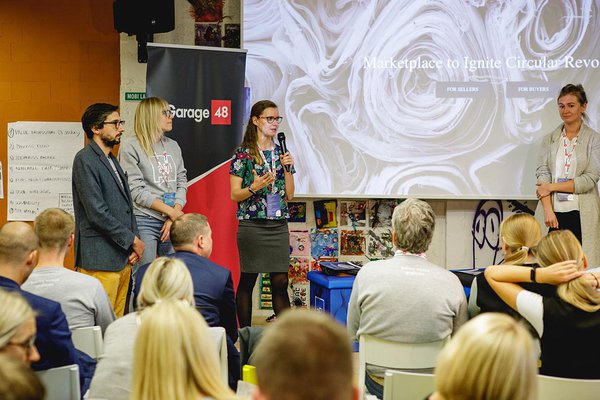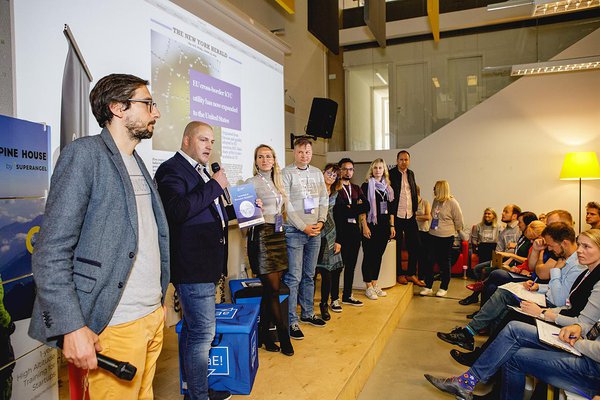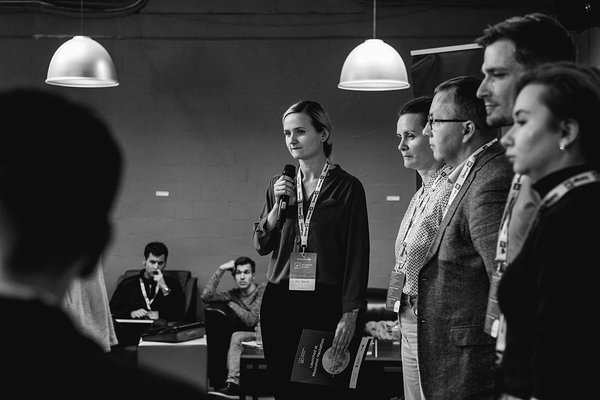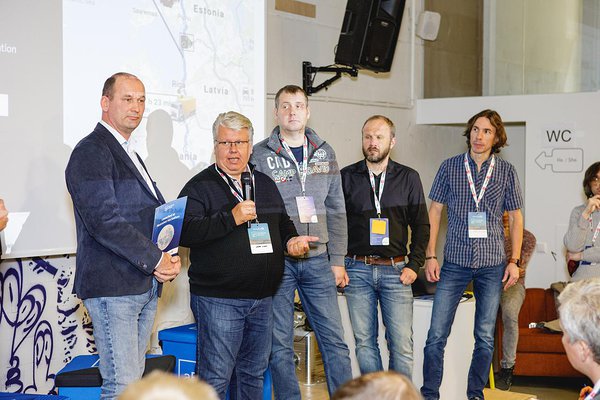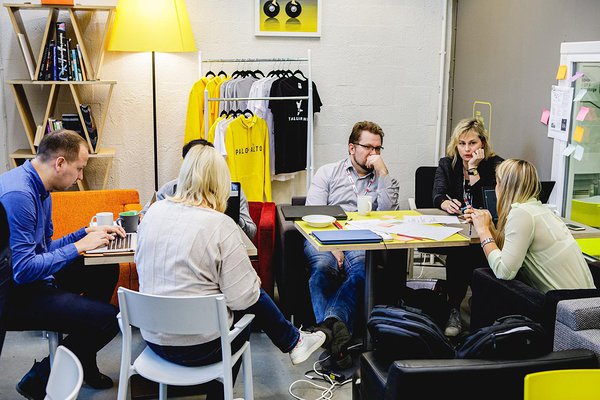What if Estonia would take the lead by initiating the development of some big scale (inter)national challenges? Something like a well known Estonian e-residency program, which first, would benefit the country and its citizens, and then have the potential to shoot for the moon?
“Estonia surely cannot lead in solving all of the global challenges that will affect the next generations, we have to choose our fights. Accelerate Estonia creates a filter to decide which of the global challenges can be solved by our people,” says Viljar Lubi, The Deputy
Secretary-General, Ministry of Economic Affairs and Communications.
The Ministry of Economic Affairs and Communications initiated a program called Accelerate Estonia (aE!) to turn wicked problems into economic development for Estonia. In close collaboration with the tech ecosystem, the Estonian government is exploring the public domains which are ripe for disruption and build models that would bring about that disruption.
Every great idea starts with a well-defined problem
AccelerateEstonia was launched at the beginning of 2018, when Viljar Lubi and Mikk Vainik from the Ministry of Economic Affairs and Communications were trying to figure out, which are the challenges different ministries are tackling and solving and how are the ideas and projects chosen in general.
“At least once every month, somebody comes to the ministry with a big, great idea about the next vision for Estonia. There is a lot of passion to help Estonia become the next fin-tech hub or a true eco-state, for example,” Mikk Vainik explains. “But the thing is that the government neither the politicians want to take the risk to start developing an idea that is not validated yet, especially with the limited resources of people and time we have.” So, with aE! program, a filter has been created, through which Estonia can decide which of these ambitions we can actually try out. “In addition, we put policy areas with appetite for innovation, in the centre of attention. There is only point in choosing the fights where the leading policymakers are up for the challenge,” adds Lubi.
In the pilot phase, 70 ideas were entered into the aE! program out of which, 10 policy areas were mapped down, out of which, the very best 17 entered into a 48h hackathon. But before the Moonshot hackathon, around 10 community building events were conducted to discuss the problems more thoroughly. “We understood that the problems and ideas presented were on an extremely different scale and that we needed a more intense and coordinated event to choose the ones we really continue working with.”
Four moonshot ideas were chosen from the 48h hackathon
Every great idea starts with a well-defined problem
AccelerateEstonia was launched at the beginning of 2018, when Viljar Lubi and Mikk Vainik from the Ministry of Economic Affairs and Communications were trying to figure out, which are the challenges different ministries are tackling and solving and how are the ideas and projects chosen in general.
“At least once every month, somebody comes to the ministry with a big, great idea about the next vision for Estonia. There is a lot of passion to help Estonia become the next fin-tech hub or a true eco-state, for example,” Mikk Vainik explains. “But the thing is that the government neither the politicians want to take the risk to start developing an idea that is not validated yet, especially with the limited resources of people and time we have.” So, with aE! program, a filter has been created, through which Estonia can decide which of these ambitions we can actually try out. “In addition, we put policy areas with appetite for innovation, in the centre of attention. There is only point in choosing the fights where the leading policymakers are up for the challenge,” adds Lubi.
In the pilot phase, 70 ideas were entered into the aE! program out of which, 10 policy areas were mapped down, out of which, the very best 17 entered into a 48h hackathon. But before the Moonshot hackathon, around 10 community building events were conducted to discuss the problems more thoroughly. “We understood that the problems and ideas presented were on an extremely different scale and that we needed a more intense and coordinated event to choose the ones we really continue working with.”
Four moonshot ideas were chosen from the 48h hackathon
“This is the most unique concept and hackathon in the world,” comments Karoli Hindriks, member of the jury, founder of Jobbatical, “First ever hackathon where a government is looking for problem solutions that can shift economy and open new global markets that would help Estonia to leap ahead of other countries. And there were ideas that have the potential, that can actually change the way we think about what countries are!”
There were three main criteria while choosing the winners of AccelerateEstonia Moonshot hackathon: “First of all, the idea itself - what is the actual problem being solved. Secondly, how big is the market being created or captured by this? For example, as we saw with the e-residency project - it has many private sector services added to it, but it all would not have been possible, if the government wouldn't have acted first,” says Viljar Lubi. “And the third important component here is the team itself - nothing happens without the core team who is ready to push the boundaries and think big.”
Here are the four ideas and teams chosen by the jury:
X-road for circular economy
“A major shift to a circular economy has started globally. The number of companies ready to start using production by-products as their manufacturing input materials is growing. But accessing the steady flow of such resources is complicated, as this is what we’re used to calling waste,” explains the project manager Mayri Tiido. “Our idea is to create a centralized online matchmaking database with live streams of manufacturing by-products and leftover materials, which could be easily reused as valuable input material instead of given to waste collection,” she adds.
X-road for circular economy allows the state to demonstrate best practices and foster new recycling and circular businesses. In addition, it allows to measure progress on how much of our economy has shifted from linear to circular. “What is more, it allows Estonia to have another success story to bring to the world and become a trailblazer in reducing waste and giving higher value to by-products,” Mayri concludes.
The key player for the implementation of this idea is the Ministry of Environment who has the necessary know-how on the Estonian manufacturing by-products as well as levers to motivate companies to participate. The ministry is interested in keeping the materials in circulation, reducing illegal dumping (especially for hazardous waste) and keeping the environment clean (literally and by CO2 emissions). By supporting the implementation of this idea, the ministry is directly supporting its own goals.
KYC as a cross-border service
Currently, it is close to impossible for a foreigner, or a foreign shareholder to open a bank account in Estonia. As well it is rather impossible for Estonian resident to open a bank account abroad. It is common to fill in long anti-money laundering declaration and additionally prove the source of the income, although such information already exists in state and government databases - they are not accessible, and not electronically recognized cross-border.
Only in Baltic states, there are at least around 40 000 obliged entities who in accordance with AML/CFT regulations must conduct KYC. But only less than 10% will really do it properly. To conduct KYC is time-money-knowledge consuming and therefore it is a kind of privilege of wealthier companies.
“Perhaps most important of all is, that the state itself does not have to contribute financially for such cross-border KYC service. Once the legislative amendments are implemented (incl. harmonization and standardization and licensing principles), due to market pressure, this KYC utility or even several competing utilities shall be created by interested parties themselves, without a need to involve any resource from public sector,” explains Rainer Osanik, Founder and Senior Partner at R.O.S Law Office. “There are already many competing products on the market, however, their usability is currently limited by lack of access to necessary data and legislative restrictions for using their data cross-border,” he adds. The data collected is machine-readable and usable for risk-assessments modules/analyses, so the obliged entities will not have to start the assessment again from zero, therewith bringing to a half the use of proceeds from crime considerably faster.
Health and pension insurance for e-residents (digital nomads)
What if Estonia was able to provide to the "homeless" digital nomads a social security system that also includes health insurance while making sure they pay their taxes to the Estonian Government? “One of the additional and high-potential ways to collect economic impact and tax revenue is to develop a package of health and pension insurance services for e-residents. There are currently 55000+ e-residents and 7500+ companies created by them,” describes the moonshot idea Liina Kadari, Head of Business Development at e-Residency.
There are almost 200 countries worldwide, each with its own social security and tax system. At the same time, there is another jurisdiction out there - the Internet. At this point, remote workers should either be affiliated to one of the national systems of their choice or rely on private health and pension insurance. Estonia could offer to digital nomads the opportunity to pay taxes in Estonia and get insurance in return.
Cross-border e-CMR
As with any business, digitization is also one of the major challenges in logistics. At the moment, there's a lack of transparency, high use of actual paper, the technological backlog, etc. One of the main issues is the documentation of goods, which, for example in the case of road transport, is largely paper-based.
“We are creating a paperless real-time e-logistics ecosystem that will streamline the supply chain and make business and government services transparent,” explains Heiti Mering, Business Development Manager at Tieto.
At the moment, the RTE initiative is addressing the problem of digitalization of road transport consignment notes (e-CMR), but this must be expanded to multimodal. In addition to road transport, rail, shipping, and aviation are also widespread in the logistics chain. They all have their own waybill system and standard. In the context of the RTE, the analysis of the common information on cargo information and the development of a common data standard need to be further addressed.
There were three main criteria while choosing the winners of AccelerateEstonia Moonshot hackathon: “First of all, the idea itself - what is the actual problem being solved. Secondly, how big is the market being created or captured by this? For example, as we saw with the e-residency project - it has many private sector services added to it, but it all would not have been possible, if the government wouldn't have acted first,” says Viljar Lubi. “And the third important component here is the team itself - nothing happens without the core team who is ready to push the boundaries and think big.”
Here are the four ideas and teams chosen by the jury:
X-road for circular economy
“A major shift to a circular economy has started globally. The number of companies ready to start using production by-products as their manufacturing input materials is growing. But accessing the steady flow of such resources is complicated, as this is what we’re used to calling waste,” explains the project manager Mayri Tiido. “Our idea is to create a centralized online matchmaking database with live streams of manufacturing by-products and leftover materials, which could be easily reused as valuable input material instead of given to waste collection,” she adds.
X-road for circular economy allows the state to demonstrate best practices and foster new recycling and circular businesses. In addition, it allows to measure progress on how much of our economy has shifted from linear to circular. “What is more, it allows Estonia to have another success story to bring to the world and become a trailblazer in reducing waste and giving higher value to by-products,” Mayri concludes.
The key player for the implementation of this idea is the Ministry of Environment who has the necessary know-how on the Estonian manufacturing by-products as well as levers to motivate companies to participate. The ministry is interested in keeping the materials in circulation, reducing illegal dumping (especially for hazardous waste) and keeping the environment clean (literally and by CO2 emissions). By supporting the implementation of this idea, the ministry is directly supporting its own goals.
KYC as a cross-border service
Currently, it is close to impossible for a foreigner, or a foreign shareholder to open a bank account in Estonia. As well it is rather impossible for Estonian resident to open a bank account abroad. It is common to fill in long anti-money laundering declaration and additionally prove the source of the income, although such information already exists in state and government databases - they are not accessible, and not electronically recognized cross-border.
Only in Baltic states, there are at least around 40 000 obliged entities who in accordance with AML/CFT regulations must conduct KYC. But only less than 10% will really do it properly. To conduct KYC is time-money-knowledge consuming and therefore it is a kind of privilege of wealthier companies.
“Perhaps most important of all is, that the state itself does not have to contribute financially for such cross-border KYC service. Once the legislative amendments are implemented (incl. harmonization and standardization and licensing principles), due to market pressure, this KYC utility or even several competing utilities shall be created by interested parties themselves, without a need to involve any resource from public sector,” explains Rainer Osanik, Founder and Senior Partner at R.O.S Law Office. “There are already many competing products on the market, however, their usability is currently limited by lack of access to necessary data and legislative restrictions for using their data cross-border,” he adds. The data collected is machine-readable and usable for risk-assessments modules/analyses, so the obliged entities will not have to start the assessment again from zero, therewith bringing to a half the use of proceeds from crime considerably faster.
Health and pension insurance for e-residents (digital nomads)
What if Estonia was able to provide to the "homeless" digital nomads a social security system that also includes health insurance while making sure they pay their taxes to the Estonian Government? “One of the additional and high-potential ways to collect economic impact and tax revenue is to develop a package of health and pension insurance services for e-residents. There are currently 55000+ e-residents and 7500+ companies created by them,” describes the moonshot idea Liina Kadari, Head of Business Development at e-Residency.
There are almost 200 countries worldwide, each with its own social security and tax system. At the same time, there is another jurisdiction out there - the Internet. At this point, remote workers should either be affiliated to one of the national systems of their choice or rely on private health and pension insurance. Estonia could offer to digital nomads the opportunity to pay taxes in Estonia and get insurance in return.
Cross-border e-CMR
As with any business, digitization is also one of the major challenges in logistics. At the moment, there's a lack of transparency, high use of actual paper, the technological backlog, etc. One of the main issues is the documentation of goods, which, for example in the case of road transport, is largely paper-based.
“We are creating a paperless real-time e-logistics ecosystem that will streamline the supply chain and make business and government services transparent,” explains Heiti Mering, Business Development Manager at Tieto.
At the moment, the RTE initiative is addressing the problem of digitalization of road transport consignment notes (e-CMR), but this must be expanded to multimodal. In addition to road transport, rail, shipping, and aviation are also widespread in the logistics chain. They all have their own waybill system and standard. In the context of the RTE, the analysis of the common information on cargo information and the development of a common data standard need to be further addressed.
Other ideas that were presented
Although four ideas were selected, there were more challenges that have the actual potential to change the world and become global.
One ID
Identity as a Service Market is $20B across the globe.
The solution is a Global Identification Platform, which is designed to scale, and exported as a digital service. But in order to make it a success on an international level government backing is needed.
Carbon Footprint
CO2 reduction targets have been set, but not enough solutions are offered how to reach these targets by 2030/2050 and effectively reduce carbon footprint. Estonia has promised to reinvest at least 50% of the revenue from emission trading back into the solutions for CO2 reduction, which according to data from 2017 would be around 20 million EUR, and so do many other countries.
The team will create a CO2 reduction crowdsourcing platform, which brings together target owners from the public sector with idea and solution providers and identifies and matches resources (capital, technology, know-how etc.) needed. Platform can also be used internationally.
NutriBy
Daily nutrition health tracking low-popularity because it's time-consuming to collect high-quality nutrition information that commonly lacks transparency & centrality, consequently 12 trillion dollars worth obesity-related diseases worldwide annually. There will be an (inter-)national customer-centered nutrition health SaaS.
TeamG /Gender Pay Gap
Gender Economic Inequality. Estonia's Gender Pay Gap was 25.6 % in 2017 (Eurostat), which the highest one in EU. Managing Gender Equality issue in the labour market is duty of the national government. Solution requires close collaboration with Statistics Estonia and the Government of Estonia. The platform created automatically calculates company's gender pay gap and its gender-based discrimination risk for its employees at the workplace.
Rohetiiger / The Green Tiger (reference to original "Tiger Leap" in IT sector)
In order to achieve targets on climate, it is critical that we transform how we design, make, and use products, and food.
A transition to Circular Economy enables us to meet the needs of a growing global population while creating a prosperous and resilient economy that is sustainable in the long term. The solution is a consensus and change implementation framework for a leap towards carbon neutrality in Estonia.
Although four ideas were selected, there were more challenges that have the actual potential to change the world and become global.
One ID
Identity as a Service Market is $20B across the globe.
The solution is a Global Identification Platform, which is designed to scale, and exported as a digital service. But in order to make it a success on an international level government backing is needed.
Carbon Footprint
CO2 reduction targets have been set, but not enough solutions are offered how to reach these targets by 2030/2050 and effectively reduce carbon footprint. Estonia has promised to reinvest at least 50% of the revenue from emission trading back into the solutions for CO2 reduction, which according to data from 2017 would be around 20 million EUR, and so do many other countries.
The team will create a CO2 reduction crowdsourcing platform, which brings together target owners from the public sector with idea and solution providers and identifies and matches resources (capital, technology, know-how etc.) needed. Platform can also be used internationally.
NutriBy
Daily nutrition health tracking low-popularity because it's time-consuming to collect high-quality nutrition information that commonly lacks transparency & centrality, consequently 12 trillion dollars worth obesity-related diseases worldwide annually. There will be an (inter-)national customer-centered nutrition health SaaS.
TeamG /Gender Pay Gap
Gender Economic Inequality. Estonia's Gender Pay Gap was 25.6 % in 2017 (Eurostat), which the highest one in EU. Managing Gender Equality issue in the labour market is duty of the national government. Solution requires close collaboration with Statistics Estonia and the Government of Estonia. The platform created automatically calculates company's gender pay gap and its gender-based discrimination risk for its employees at the workplace.
Rohetiiger / The Green Tiger (reference to original "Tiger Leap" in IT sector)
In order to achieve targets on climate, it is critical that we transform how we design, make, and use products, and food.
A transition to Circular Economy enables us to meet the needs of a growing global population while creating a prosperous and resilient economy that is sustainable in the long term. The solution is a consensus and change implementation framework for a leap towards carbon neutrality in Estonia.
Onestopshop for developer who wants to build
The process of designing living environment is very fragmented, time consuming, inefficient and not friendly to any involved counterparts (decision makers, developers/investors, citizens). There is a need to have a holistic view of urban and rural spatial planning and to create more sophisticated integrated solutions for buildings, facilities, developments, including energy, transport and logistics. Market worth billions of euros.
The design of urban and rural spaces should be organised in one place - a digital data exchange platform that combines together information from building and planning register. The exportable parts is concept, know-how and technical solutions.
SatLog. Satellites on service!
Environmental monitoring is not relying on real time data. There are loads of satellite data to use but it is to complicated. Market size: public: Estonian and foreign authorities responsible for environmental management including ministries, inspectorates, local goverments. Private: environmental assessment, forestry, mining companies, also real estate and insurance.For a solution, there would be a toolbox for satellite data visualization including basic change detection interpretation that could be linked to public and private information systems.
KRATT
There is no common knowledge of how to transfer personal data to third parties. General Data Protection Regulation points out that data should move, but nobody knows how. In Estonian financial sector there are interest rates on consumer loans 3 times higher than in Europe average. It's because lack of competition, lack of data and lack of capital. By making data freely movable, Estonian consumer loan market (1 billion) could save people 100 million euros every year. In Eastern Europe alone, bringing down interest rates would be up to 10 billion euro market. If Estonia solves out how to make personal data under GDPR freely movable, same solutions can be implemented in every European country, with the backing of the world largest financial institutions and data companies.
RAPAKP
The problem is that money laundering is not detected in Estonia. And in Europe. And in the world. That is our market.
The team is creating an API gathering data from banks into central analysis registry which applies risk scenarios and matches the data to information in state registries. By that the investigation time is shortened. API can be exported as well as tailor made risk scenarios.
Animal and bird monitoring and species identification by image recognition
Large numbers of animal (including bird) images of animals from various sources are generated every day in Estonia, with a wealth of information on the occurrence and abundance of different species, diseases, habitats, pathways, etc.However, the ability to use the information contained in the images is currently insufficient. The images are viewed, interpreted and analyzed one by one. Many large photo banks containing potentially useful information have not been reviewed at all. The problem is that one-by-one review of images is very time consuming, and there may be a lack of knowledge necessary for species identification. There is currently no solution for automatic identification of species from pictures in Estonia. Similar solutions in neighboring countries are also not available.
Solution would be a machine learning platform being, where both single photos and large photo banks can be inserted.
Fruit&Vegetables
Estonian population eats too little fruits and vegetables. The root cause of the problem seems to be low reputation of eating fruits and vegetables + several other problems including the price of the products, availability, fear of pesticides etc.
A “happy” lunchbox for students would be a good start.
The process of designing living environment is very fragmented, time consuming, inefficient and not friendly to any involved counterparts (decision makers, developers/investors, citizens). There is a need to have a holistic view of urban and rural spatial planning and to create more sophisticated integrated solutions for buildings, facilities, developments, including energy, transport and logistics. Market worth billions of euros.
The design of urban and rural spaces should be organised in one place - a digital data exchange platform that combines together information from building and planning register. The exportable parts is concept, know-how and technical solutions.
SatLog. Satellites on service!
Environmental monitoring is not relying on real time data. There are loads of satellite data to use but it is to complicated. Market size: public: Estonian and foreign authorities responsible for environmental management including ministries, inspectorates, local goverments. Private: environmental assessment, forestry, mining companies, also real estate and insurance.For a solution, there would be a toolbox for satellite data visualization including basic change detection interpretation that could be linked to public and private information systems.
KRATT
There is no common knowledge of how to transfer personal data to third parties. General Data Protection Regulation points out that data should move, but nobody knows how. In Estonian financial sector there are interest rates on consumer loans 3 times higher than in Europe average. It's because lack of competition, lack of data and lack of capital. By making data freely movable, Estonian consumer loan market (1 billion) could save people 100 million euros every year. In Eastern Europe alone, bringing down interest rates would be up to 10 billion euro market. If Estonia solves out how to make personal data under GDPR freely movable, same solutions can be implemented in every European country, with the backing of the world largest financial institutions and data companies.
RAPAKP
The problem is that money laundering is not detected in Estonia. And in Europe. And in the world. That is our market.
The team is creating an API gathering data from banks into central analysis registry which applies risk scenarios and matches the data to information in state registries. By that the investigation time is shortened. API can be exported as well as tailor made risk scenarios.
Animal and bird monitoring and species identification by image recognition
Large numbers of animal (including bird) images of animals from various sources are generated every day in Estonia, with a wealth of information on the occurrence and abundance of different species, diseases, habitats, pathways, etc.However, the ability to use the information contained in the images is currently insufficient. The images are viewed, interpreted and analyzed one by one. Many large photo banks containing potentially useful information have not been reviewed at all. The problem is that one-by-one review of images is very time consuming, and there may be a lack of knowledge necessary for species identification. There is currently no solution for automatic identification of species from pictures in Estonia. Similar solutions in neighboring countries are also not available.
Solution would be a machine learning platform being, where both single photos and large photo banks can be inserted.
Fruit&Vegetables
Estonian population eats too little fruits and vegetables. The root cause of the problem seems to be low reputation of eating fruits and vegetables + several other problems including the price of the products, availability, fear of pesticides etc.
A “happy” lunchbox for students would be a good start.
Making Estonia even greater
Although four teams with most potential were selected, it is just the beginning of a long, winding road for everybody. “We will get together with all the teams and write down a detailed plan on how to continue,” describes Mikk Vainik, the head of aE! program. Each team gets the full attention of the government, up to 100 000 EUR to support their work, a 9-month contract for the project manager and a possibility to engage extra resources and services. “It should be clear by spring if Estonia will be the next crypto-kingdom or the next 100% eco-friendly country, or whatever else the next big things are for us” concludes Vainik. “If within 9 months, the ideas turn out to be successful, we will continue supporting them. When there is a clear need to drive major changes in the state, it is in our interest to continue investing, so that one day, the whole Estonia could benefit out of it.”
Although four teams with most potential were selected, it is just the beginning of a long, winding road for everybody. “We will get together with all the teams and write down a detailed plan on how to continue,” describes Mikk Vainik, the head of aE! program. Each team gets the full attention of the government, up to 100 000 EUR to support their work, a 9-month contract for the project manager and a possibility to engage extra resources and services. “It should be clear by spring if Estonia will be the next crypto-kingdom or the next 100% eco-friendly country, or whatever else the next big things are for us” concludes Vainik. “If within 9 months, the ideas turn out to be successful, we will continue supporting them. When there is a clear need to drive major changes in the state, it is in our interest to continue investing, so that one day, the whole Estonia could benefit out of it.”
